
What Is Melanoma
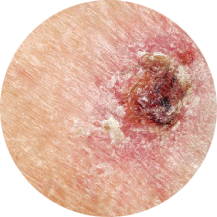
Melanoma is a type of cancer occurring in cells that color the skin called melanocytes. Located in the lower part of the epidermis, these cells produce melanin. When the skin is exposed to the sun, melano-cytes produce more pigment, causing the skin to darken, or tan. The most aggressive form of skin cancer, Melanoma can occur anywhere on the body. If detected and treated early, it is curable in most instances. Once it advances, however, it can be difficult to treat. Melanoma cases have increased over the past 10 years more rapidly than that of any other cancer,1 with more than 70,000 cases reported each year.2 The best defense against Melanoma is to stay out of the sun, use potent topical sunblocks, and have a physician or dermatologist regularly check pigmented areas of your skin for changes.

Who is most affected?
In men, Melanoma is often found on the upper trunk (between the shoulders and hips), head, or neck. In women, this cancer often develops on the arms and legs. While common in adults, Melanoma often develops in children and teens. Risk factors include unusual moles, sun exposure, ultraviolet light exposure (tanning booths), and a personal or family history of Melanoma. Caucasians – especially those with blue eyes, red or blonde hair, or freckles – have an increased likelihood of having Melanoma.
How is it Diagnosed?
Your dermatologist or specialist conducts a thorough skin examination, looking for abnormalities in moles, birthmarks, or other pigmented areas. If a suspicious lesion or area is found, the dermatologist will take a biopsy for the dermatopathologist to examine under a microscope. In some cases, a dermatologist may use a diagnostic tool called dermoscopy to examine a lesion before taking a biopsy sample. If the dermatopathologist finds malignant cells in the biopsy, your dermatologist may order other tests to find out whether or not the cancer has spread.
These tests help the dermatopathologist assess the location, spread, and stage of the Melanoma. Stage 1 Melanomas are relatively small tumors confined to the location of the original tumor. In stage 4, cancer has spread throughout the body. Stages 2 & 3 describe conditions in between these two extremes. Melanomas that are detected at an early stage have a 99% chance for a 5-year survival rate.3
How is Treatment Determined?
The dermatopathologist consults with your dermatologist after reviewing the test results and determining the stage of the cancer. Together, using their combined experience and knowledge, they determine treatment options appropriate for your condition.
Skin cancer is the most common of all cancers,
yet it is the easiest to cure if diagnosed and treated early.
Spotting Melanoma with the ABC's Skin Test
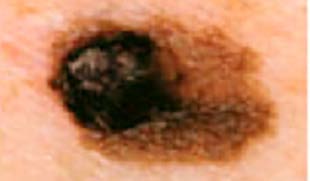 |
AsymmetryOne half does not match the other |
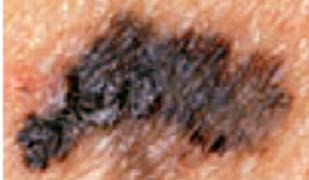 |
BordersBorder Irregularity |
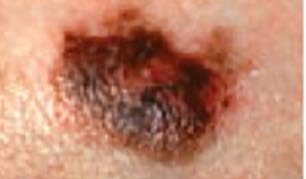 |
ColorVaried shades of black, brown, and tan |
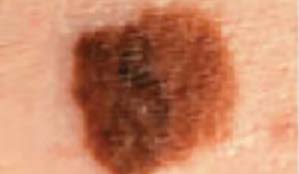 |
DiameterGreater than six millimeters |
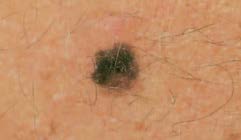
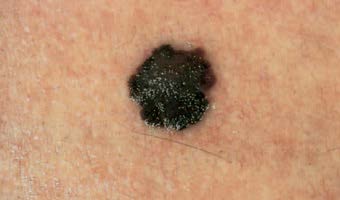
|
EvolvingChange in size, shape, or shade of color |

What treatment options are available?
Melanoma can be treated through one or more of the following: surgery, chemotherapy, radiation therapy, as well as new investigative treatments. It’s important to learn as much as you can about the nature of your cancer and your treatment options and to make the decision that’s right for you.
- The Purpose of Surgery is to remove the tumor. If the cancer cannot be removed through local excision or wide local excision, the surgeon may conduct a lymphadectomy (removal and examination of lymph nodes for cancer). Skin grafting (taking skin from another part of the body) may be performed to replace the skin that is removed.
-
Chemotherapy uses drugs to stop the growth of cancer cells. Systemic chemotherapy kills or stops cells from dividing throughout the body. Regional chemotherapy is directed at a specific part of the body, focusing the treatment there and sparing normal cells from damage. To treat Melanoma in an arm or leg, chemotherapy drugs may be given as a hyperthermic isolated limb perfusion. This technique sends anti-cancer drugs directly to the arm or leg where the cancer is located.
-
Radiation Therapy uses high-energy, pinpointed x-rays to kill cancer cells. This type of treatment is directed at specific areas. It can be used to treat small tumors, minimizing the damage to normal cells or tissue surrounding the tumor, or can be used to destroy cancer cells that remain after surgery.


